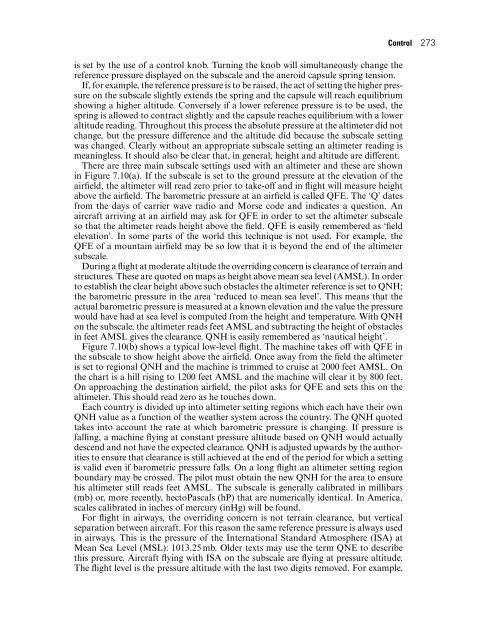The Art of the Helicopter John Watkinson - Karatunov.net
The Art of the Helicopter John Watkinson - Karatunov.net
The Art of the Helicopter John Watkinson - Karatunov.net
You also want an ePaper? Increase the reach of your titles
YUMPU automatically turns print PDFs into web optimized ePapers that Google loves.
is set by <strong>the</strong> use <strong>of</strong> a control knob. Turning <strong>the</strong> knob will simultaneously change <strong>the</strong><br />
reference pressure displayed on <strong>the</strong> subscale and <strong>the</strong> aneroid capsule spring tension.<br />
If, for example, <strong>the</strong> reference pressure is to be raised, <strong>the</strong> act <strong>of</strong> setting <strong>the</strong> higher pressure<br />
on <strong>the</strong> subscale slightly extends <strong>the</strong> spring and <strong>the</strong> capsule will reach equilibrium<br />
showing a higher altitude. Conversely if a lower reference pressure is to be used, <strong>the</strong><br />
spring is allowed to contract slightly and <strong>the</strong> capsule reaches equilibrium with a lower<br />
altitude reading. Throughout this process <strong>the</strong> absolute pressure at <strong>the</strong> altimeter did not<br />
change, but <strong>the</strong> pressure difference and <strong>the</strong> altitude did because <strong>the</strong> subscale setting<br />
was changed. Clearly without an appropriate subscale setting an altimeter reading is<br />
meaningless. It should also be clear that, in general, height and altitude are different.<br />
<strong>The</strong>re are three main subscale settings used with an altimeter and <strong>the</strong>se are shown<br />
in Figure 7.10(a). If <strong>the</strong> subscale is set to <strong>the</strong> ground pressure at <strong>the</strong> elevation <strong>of</strong> <strong>the</strong><br />
airfield, <strong>the</strong> altimeter will read zero prior to take-<strong>of</strong>f and in flight will measure height<br />
above <strong>the</strong> airfield. <strong>The</strong> barometric pressure at an airfield is called QFE. <strong>The</strong> ‘Q’ dates<br />
from <strong>the</strong> days <strong>of</strong> carrier wave radio and Morse code and indicates a question. An<br />
aircraft arriving at an airfield may ask for QFE in order to set <strong>the</strong> altimeter subscale<br />
so that <strong>the</strong> altimeter reads height above <strong>the</strong> field. QFE is easily remembered as ‘field<br />
elevation’. In some parts <strong>of</strong> <strong>the</strong> world this technique is not used. For example, <strong>the</strong><br />
QFE <strong>of</strong> a mountain airfield may be so low that it is beyond <strong>the</strong> end <strong>of</strong> <strong>the</strong> altimeter<br />
subscale.<br />
During a flight at moderate altitude <strong>the</strong> overriding concern is clearance <strong>of</strong> terrain and<br />
structures. <strong>The</strong>se are quoted on maps as height above mean sea level (AMSL). In order<br />
to establish <strong>the</strong> clear height above such obstacles <strong>the</strong> altimeter reference is set to QNH;<br />
<strong>the</strong> barometric pressure in <strong>the</strong> area ‘reduced to mean sea level’. This means that <strong>the</strong><br />
actual barometric pressure is measured at a known elevation and <strong>the</strong> value <strong>the</strong> pressure<br />
would have had at sea level is computed from <strong>the</strong> height and temperature. With QNH<br />
on <strong>the</strong> subscale, <strong>the</strong> altimeter reads feet AMSL and subtracting <strong>the</strong> height <strong>of</strong> obstacles<br />
in feet AMSL gives <strong>the</strong> clearance. QNH is easily remembered as ‘nautical height’.<br />
Figure 7.10(b) shows a typical low-level flight. <strong>The</strong> machine takes <strong>of</strong>f with QFE in<br />
<strong>the</strong> subscale to show height above <strong>the</strong> airfield. Once away from <strong>the</strong> field <strong>the</strong> altimeter<br />
is set to regional QNH and <strong>the</strong> machine is trimmed to cruise at 2000 feet AMSL. On<br />
<strong>the</strong> chart is a hill rising to 1200 feet AMSL and <strong>the</strong> machine will clear it by 800 feet.<br />
On approaching <strong>the</strong> destination airfield, <strong>the</strong> pilot asks for QFE and sets this on <strong>the</strong><br />
altimeter. This should read zero as he touches down.<br />
Each country is divided up into altimeter setting regions which each have <strong>the</strong>ir own<br />
QNH value as a function <strong>of</strong> <strong>the</strong> wea<strong>the</strong>r system across <strong>the</strong> country. <strong>The</strong> QNH quoted<br />
takes into account <strong>the</strong> rate at which barometric pressure is changing. If pressure is<br />
falling, a machine flying at constant pressure altitude based on QNH would actually<br />
descend and not have <strong>the</strong> expected clearance. QNH is adjusted upwards by <strong>the</strong> authorities<br />
to ensure that clearance is still achieved at <strong>the</strong> end <strong>of</strong> <strong>the</strong> period for which a setting<br />
is valid even if barometric pressure falls. On a long flight an altimeter setting region<br />
boundary may be crossed. <strong>The</strong> pilot must obtain <strong>the</strong> new QNH for <strong>the</strong> area to ensure<br />
his altimeter still reads feet AMSL. <strong>The</strong> subscale is generally calibrated in millibars<br />
(mb) or, more recently, hectoPascals (hP) that are numerically identical. In America,<br />
scales calibrated in inches <strong>of</strong> mercury (inHg) will be found.<br />
For flight in airways, <strong>the</strong> overriding concern is not terrain clearance, but vertical<br />
separation between aircraft. For this reason <strong>the</strong> same reference pressure is always used<br />
in airways. This is <strong>the</strong> pressure <strong>of</strong> <strong>the</strong> International Standard Atmosphere (ISA) at<br />
Mean Sea Level (MSL): 1013.25 mb. Older texts may use <strong>the</strong> term QNE to describe<br />
this pressure. Aircraft flying with ISA on <strong>the</strong> subscale are flying at pressure altitude.<br />
<strong>The</strong> flight level is <strong>the</strong> pressure altitude with <strong>the</strong> last two digits removed. For example,<br />
Control 273










